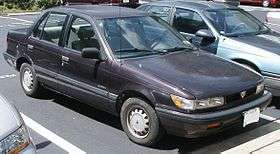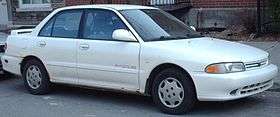Eagle Summit
| Eagle Summit | |
|---|---|
 | |
| Overview | |
| Manufacturer | |
| Production | 1989–1996 |
| Body and chassis | |
| Class | Subcompact [1] |
| Chronology | |
| Predecessor |
|
| Successor | Plymouth Neon |
The Eagle Summit is a subcompact car that was produced by Mitsubishi and sold by Eagle from 1989 to 1996. It was sold as a captive import by the Jeep-Eagle sales division that was created after Chrysler Corporation purchased American Motors Corporation (AMC) in 1987.
Overview
The Eagle Summit joined the Dodge Colt and Plymouth Colt starting in 1989 as Chrysler wound down the production of the subcompact Plymouth Horizon and Dodge Omni twins.[2] The introduction of the Summit coincided with the release of the Mitsubishi Mirage's third generation.
The Eagle Summit was the subcompact automobile model in the product mix for Jeep-Eagle dealers.[3] Previously this position was held by the Renault Alliance until Renault withdrew from the U.S. and Canadian markets in 1987. The Eagle Summit line lasted through the extent of the Mirage's fourth generation, which ended in 1996. The somewhat related Eagle Summit Wagon (which was a compact MPV) ran from 1992–1996 and was based on the Mitsubishi RVR.
The Chrysler Neon was introduced in January 1994 and was marketed by Dodge and Plymouth dealers. Chrysler officials declared that no Eagle version of the Neon was planned leaving Eagle dealers with a competitor to the Neon, and combined with the Summit's Mitsubishi heritage made the line expendable.[1]
Year-to-year changes
First generation (1989-1992)
| First generation | |
|---|---|
|
| |
| Overview | |
| Production | 1989–1992 |
| Assembly |
|
| Body and chassis | |
| Body style | |
| Layout | FF layout |
| Related | |
| Powertrain | |
| Engine |
|
| Transmission | |
| Dimensions | |
| Wheelbase |
|
| Length |
|
| Width | 65.7 in (1,669 mm) |
| Height |
|
| Curb weight |
|
The Summit was a badge engineered version of the Mitsubishi Mirage. In a pairing of the Japanese-built Mitsubishi Mirage and the identical Eagle Summit to test if Lee Iacocca's theory was true regarding the preference of a Japanese to an American brand on similar cars, Popular Mechanics found that American consumers were "not sold on Japanese cars. Quite the opposite. They want to "Buy American," but the Japanese manufacturers seem to offer more of the type of cars Americans need and at a better price, and from more cooperative dealers."[5] Originally assembled in Japan, starting with the 1991 model year, the Eagle Summits were built by Diamond-Star Motors (DSM), a joint-venture between Chrysler and Mitsubishi, in Normal, Illinois.[6]
- 1989: Summit was introduced as a sedan in DL and LX trim, both powered by a 1.5-liter 8-valve 4-cylinder engine with 81 hp (60 kW). The LX could have a 1.6-liter 16-valve DOHC engine with 123 hp (92 kW). The 100.7 cubic feet (2.85 m3) of interior volume classified the Summit into the compact car class, while most of its competitors were still subcompacts. The Summit was also noted for its generous rear legroom.
- 1990: A low-cost base model was added to the bottom of the Summit line. Added to the top was a new ES, which paired the 1.6-liter engine with a sport suspension, 4-wheel-disc brakes, and 14-inch (360 mm) alloy wheels with P195/60R14 tires. All models received all-capital lettering on the back.
.jpg)
- 1991: The 1.5-liter engine output increased to 92 hp (69 kW; 93 PS) due to 4 additional valves (for 12 total). The ES models returned to 13-inch (330 mm) wheels and disc brakes on only the front. New was the 2-door Summit hatchback; both it and the sedan came in base and ES trims. The manual transmission was a 4-speed on the base hatchback and a 5-speed on all others; the automatic was a 3-speed on hatchbacks and a 4-speed on sedans. All models featured a new front grille.
- 1992: The Summit Wagon joined the line, and it was a completely different vehicle featuring a high roofline and sliding rear side door. This "crossover" design was actually a rebadged Mitsubishi RVR, thus not related to the Mirage-based Summits. The Wagon was available in DL and LX trims, as well as in a four-wheel drive (AWD) version. The new Summit Wagon was marketed as blending the maneuverability of a small car with the roominess of a minivan with its interior offering high seating positions and removable rear seats.[7] It was designed to attract young families with seating for five.[8]
Second generation (1993-1996)
| Second generation | |
|---|---|
 | |
| Overview | |
| Also called | Wagon: Mitsubishi Space Runner (Europe) [9] |
| Production | 1993–1996 |
| Assembly | Kurashiki, Okayama, Japan (Coupe & Sedan) |
| Body and chassis | |
| Body style | |
| Layout | Front engine, front-wheel drive |
| Related | |
| Powertrain | |
| Engine |
|
| Transmission | |
| Dimensions | |
| Wheelbase |
|
| Length |
|
| Width |
|
| Height |
|
| Curb weight | Wagon: 2,700 lb (1,225 kg) |
The 1993 model year Summits were completely new and featured more room on the inside as well as weighing less than before.[10] The Summit was now based the fourth generation Mitsubishi Mirage 'CC' chassis platform featuring a mutlilink rear suspension and the body was given a rounder shape.
The hatchback body design, which were previously popular in this market segment, was dropped in favor of a two-door coupe version, while a four-door sedan joined the Summit lineup offering "good basic transportation".[10] The sedan was described as "a commuter vehicle for those needing to hold four people and a trunk full of groceries or luggage" offering high fuel mileage and "function," not "flash."[1]


The Summit Wagon was described as not being the station wagon version of the Summit coupe and sedan, but "rather, it is a combination sub-compact wagon and minivan."[11] This model represented an early entry into an automotive segment in the U.S. that took five years before another "tall wagon" came to market that included the Chrysler PT Cruiser for 2001 and Scion xB for 2004.[12]
- 1993: As with the Mirage and both Colts, the base 1.5-liter engine remained, paired to a 5-speed manual or 3-speed automatic. New was a 113 hp (84 kW; 115 PS) 1.8-liter SOHC engine, whose optional automatic was a 4-speed. The Summit came in sedan and coupe body styles, DL and ES trim lines. At first, only the ES sedan had the better powertrain. A RVR-based minivan version (called the Summit Wagon) replaced the Canada-only Eagle Vista wagon.
- 1994: All Summits featured a driver's side airbag, replacing one of the motorized seatbelts. The lower-end DL sedan was rebadged LX and inherited the 1.8-liter engine, which was now an option for the ES coupe as well. The ES sedan upgraded to larger 14-inch (360 mm) wheels.
- 1995: A passenger's side airbag on all Summits replaced the other motorized seatbelt, and ES models were renamed ESi. More significantly, the 1994 demise of both Colts left the Summit as the only remaining Mirage clone, and the cancellation of the Mirage sedan at the end of 1994 left the Summit as the only four-door offering.
- 1996: Summit entered its last model year with new paint colors, while the wagon, "a funky cross between a sedan and a minivan, gets new colors and seat fabrics."[13]
Trim levels overview
- 4-door sedan (1989-1996)
- DL - 1989-1990; 1993
- LX - 1989-1990; 1994–1996
- base - 1990-1992
- ES - 1990-1994
- ESi - 1994-1996
- 2-door coupe (1991-1996)
- base - 1991-1992
- ES - 1991-1994
- DL - 1993-1996
- ESi - 1994-199
References
- 1 2 3 Mateja, Jim (22 March 1993). "Inside Story On '93 Eagle Summit: Plenty Of Space, Few Safety Features". Chicago Tribune. Retrieved 11 October 2015.
Summit may be ranked as a subcompact based on exterior dimensions, but it has interior room most midsize cars would envy.
- ↑ McCosh, Dan (November 1990). "Global Designs for Compact Sedans". Popular Science. 237 (5): 92. Retrieved 11 October 2015.
- ↑ Dunne, Jim (June 1988). "Inside Detroit". Popular Mechanics: 43. Retrieved 11 October 2015.
- ↑ Mateja, Jim (17 May 1991). "New Line Of Work For Chrysler Plant: Subcompact To Replace Full-size Cars At Belvidere". Chicago Tribune. Retrieved 11 October 2015.
- ↑ Taylor, Rich (November 1990). "Blind Taste Test". Popular Mechanics. 167 (11): 41–125. Retrieved 11 October 2015.
- ↑ Taylor, p. 46.
- ↑ Winternitz, Felix (October 1991). "Hot Wheels '92". Cincinnati Magazine. 25 (1): 108. Retrieved 11 October 2015.
- ↑ "What's new for '92? Check these models". Kiplinger's Personal Finance. 45 (10): 107. October 1991. Retrieved 11 October 2015.
- ↑ Martin, Murilee (12 February 2014). "Junkyard Find: 1993 Eagle Summit Wagon". The Truth About Cars. Retrieved 11 October 2015.
- 1 2 Allen, Mike (October 1992). "Drive Report: Eagle Summit". Popular Mechanics. 169 (10): 39. Retrieved 11 October 2015.
- ↑ Gillis, Jack (1996). The Car Book. Tilden Press. ISBN 9780062732828. Retrieved 11 October 2015.
- ↑ Lilienthal, Andy (20 April 2009). "Nostalgic Subcompact: Tall wagon triplets—Mitsubishi Expo LRV, Eagle Summit Wagon, and Plymouth Colt Vista". Subcompact Culture. Retrieved 11 October 2015.
- ↑ Edmunds Used Cars and Trucks Summer 2001. Edmund Publications. 2001. pp. 166–167. ISBN 9780877596691.
External links
| Wikimedia Commons has media related to Eagle Summit. |
- Eagle Summit at the Internet Movie Cars Database
| « AMC — Eagle road car timeline, 1988–1998 | |||||||||||
|---|---|---|---|---|---|---|---|---|---|---|---|
| Type | 1980s | 1990s | |||||||||
| 8 | 9 | 0 | 1 | 2 | 3 | 4 | 5 | 6 | 7 | 8 | |
| Subcompact | Summit | Summit | |||||||||
| Vista | |||||||||||
| Mid-size | Medallion | 2000GTX | |||||||||
| Full-size | Premier | Vision | |||||||||
| Sports car | Talon | Talon | |||||||||
| Crossover | Wagon | Vista Wagon | Summit Wagon | ||||||||
| Vehicle sold under both Renault and Eagle marques | |||||||||||